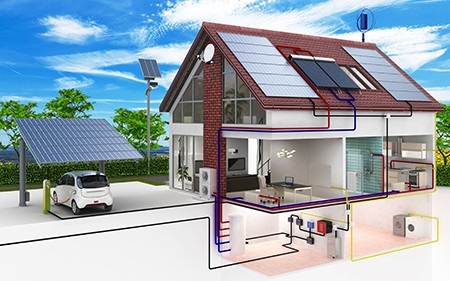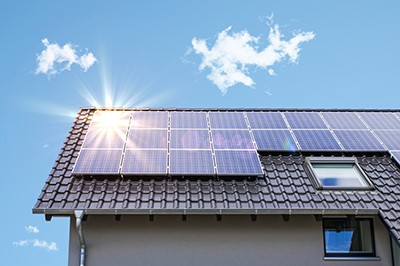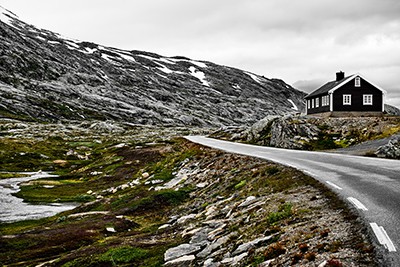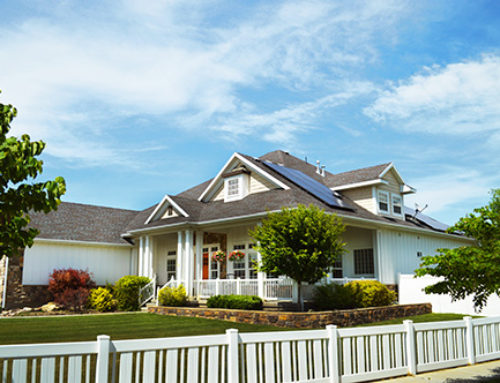Did you know that solar energy is continuing to growing in popularity with homeowners?

Each year more and more people are beginning to understand how installing solar systems in their homes can meet all their energy needs, save them money and help with environmental sustainability. Roof solar systems produce more than enough clean energy electricity to light, heat and power most homes. Some homeowners even use net metering to sell the excess energy their photovoltaic energy systems generate to the local power company. With the money saved on energy bills, the pv energy system will pay for itself in about 7.8 years.
In this article you will learn more about solar energy and understand why it is becoming more and more common for homeowners to switch over to solar.
How Solar Energy Works
Enough solar energy hits the earth in one hour to meets all the energy needs of everyone on the planet for an entire year.

Rooftop PV energy systems capture solar energy and transform it into electricity. That electricity can be stored in a solar battery or on the local power grid. The home can draw on that energy to power the lights and other systems in the home at night, on cloudy days or other times there’s no sunshine. Solar generated power is cleaner that fossil fuels like oil and coal. It does not release carbon dioxide and other greenhouse gasses while generating power to run lights and appliances and generate heat.
The Internal Workings
The solar panels that are used to capture sunshine and generate electricity have four basic parts. They are a metal frame, silicon cells, a glass casing, as well a group of wires through which the current from the silicon cells flows. Although silicon isn’t a metal, its conductive properties enable it to absorb sunlight and convert it into electricity. Light hits the silicon cell, sets the electrons in motion and starts the flow of electric current. Called the ‘photovoltaic effect’, it describes the way solar panel technology functions. Solar radiation is absorbed by silicon photovoltaic solar cells. The movement of the electrons produces electric current which is captured by the panel’s nodes and wiring. This direct current electricity flows through the wires to a solar inverter and is transformed into alternating current electricity.
Different Types Of Solar Energy
Not all solar energy is exactly the same.

There are two common types of solar energy. One type is called solar thermal energy. It gathers energy from the sun using water or a mixture that contains anti-freeze. The second type of solar energy is called solar photovoltaic energy. This method uses photovoltaic cells to convert energy from the sun into electricity homeowners can use every day. Both of these methods can be used with either off-grid solar systems or be connected to the local power grid. These two types of solar energy are effective, clean, home energy sources.
Modularity And Flexibility
People interested in installing solar energy in home systems have a number of viable options from which to choose. Solar electricity’s modularity and flexibility allows it to be tailored to each homeowner’s specific and unique needs and desires. Solar generated power can be used to provide full or partial electrical power for a home or can be used for specific projects. In addition to lights and appliances, solar energy in house systems can be used to power well pumps, home security systems, patio lighting, backyard waterfalls and other landscaping elements.
Home Solar Energy Systems
There are three primary types of solar power systems. They are standalone, utility grid connect and battery backup. Any of them can be used to handle part or all of any home’s electrical power needs.

Standalone type DC systems are usually used as a utility power substitute. During daylight hours, photovoltaic arrays charge the battery so it can supply power when needed. Standalone AC-DC systems perform like the standalone DC systems except they employ DC to AC inverters. This enables these solar systems to power computers, power tools, kitchen appliances and more.
Backup AC solar systems normally come with a battery bank, one or more inverters and a 10 or more module photovoltaic array. Utility interconnected grid-tied systems are the simplest solar systems. They don’t need batteries for backup because they add to and draw from the existing power grid. They can help homeowners save money through net metering.
Benefits Of Using Solar Energy
Wholesale solar energy use provides homeowners with a whole host of benefits. It lowers the monthly energy bills, reduces the amount of air pollution that’s produced to heat and power a home, it creates a growing number of clean green power jobs and allows people to make a meaningful contribution towards environmental sustainability. In the 41 states where net metering is available, wholesale solar power use can actually put money in homeowners’ pockets. Plus, installing solar energy in home systems increases the property value of the home by $15,000 on average. That’s true whether they install simple solar panel kits or complex off-grid solar systems.
Using Solar Generated Power At Night
Homes are lit and powered by PV energy systems and energy captured by solar panel kits at night. The clean energy electricity produced and stored during daylight is used to light, heat and power the homes after dark. For people living in solar powered homes, there is no discernable difference in the quality of the electricity services they receive than people who use the local power company. Just flip the switch and the lights, radio, television and other appliances start right up. Solar energy in home systems deliver clean energy electricity day and night.
Living Off The Grid
One of the benefits of using solar power to provide one’s electricity is it gives homeowners the freedom to live off the grid.

Once people have enough solar panel kits and large enough PV energy systems, they can unplug from the local power company and capture and transform all the solar energy they need to generate the electricity they need to be self-sustaining. A growing number of people are using off-grid solar systems to give themselves the freedom and independence to build their homes wherever they want. Their homes have all the conveniences and appliances powered by sunshine.
Making The World Better
People now have the ability to help the planet to heal itself by simply changing their home energy sources from high polluting coal, oil and other fossil fuels to clean, green, solar energy. Wholesale solar energy use for generating heat and electricity can have a profound, positive, impact on the environment. The ability to choose to use clean solar energy to provide the power needed to run the systems and appliances in homes and businesses nationwide allows the average person to play a significant role in helping with environmental sustainability. The benefits to the planet of switching to solar energy are many, diverse and begin almost immediately.
Room For Growth
Currently only about 0.6 of America’s energy needs are met through using solar power. For a small investment that increases property values significantly and can be quickly recouped by lower energy bills, millions more people can switch to solar energy to power their homes. That will create hundreds of thousands of new green jobs, help to reduce air pollution and benefit the environment in many important ways. The US Department of Energy predicts almost 4 million homes will switch to solar energy over the next decade. That is a great start. By gradually increasing the number of solar-powered homes, Americans can move from simply talking about reducing pollution and the strain on the Earth’s natural systems and saving the planet and begin to make it a reality.
